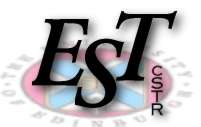Synthesize a signal from a single set of linear prediction coefficients and the residual values.
Filter the waveform using a single set of coefficients so as to produce a residual signal.
Synthesize a signal from a track of linear prediction coefficients.
Synthesize a signal from a track of linear prediction coefficients.
Produce a residual from a track of linear prediction coefficients and a signal using an overlap add technique.



